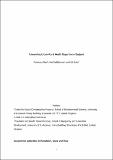Files in this item
Unravelling urban-rural health disparities in England
Item metadata
| dc.contributor.author | Allan, Rebecca | |
| dc.contributor.author | Williamson, Paul | |
| dc.contributor.author | Kulu, Hill | |
| dc.date.accessioned | 2019-05-07T23:37:15Z | |
| dc.date.available | 2019-05-07T23:37:15Z | |
| dc.date.issued | 2017-11 | |
| dc.identifier | 249386318 | |
| dc.identifier | 9eeb7c20-94b6-47e8-a1f0-43f027cc503b | |
| dc.identifier | 85019041422 | |
| dc.identifier | 000414472800008 | |
| dc.identifier.citation | Allan , R , Williamson , P & Kulu , H 2017 , ' Unravelling urban-rural health disparities in England ' , Population, Space and Place , vol. 23 , no. 8 , e2073 . https://doi.org/10.1002/psp.2073 | en |
| dc.identifier.issn | 1544-8444 | |
| dc.identifier.other | ORCID: /0000-0001-8808-0719/work/75996984 | |
| dc.identifier.uri | https://hdl.handle.net/10023/17659 | |
| dc.description | Rebecca Allan's research was supported by the Economic and Social Research Council (PhD project: “Residential Context, Health and Mortality: The Effect of Context, Composition or Selective Migrations?”). | en |
| dc.description.abstract | Previous research shows significant health and mortality variations by residential context. Numerous studies report better health and lower mortality among rural populations in comparison to urban residents, whereas other research shows the opposite, with poor health and high mortality in rural areas. This study investigates health variations in England by residential contexts and the causes of such differences. Further, it examines the sensitivity of results to different rural-urban classifications. Applying logistic regression models to individual-level data from the 2001 UK census we demonstrate significant health variation by residential context. A clear urban-rural positive health gradient is apparent, with levels of ill health increasing parallel to levels of urbanisation. Briefly, people living in rural areas have better health than those living in cities and other urban contexts. However, the capital city (London) provides an exception to the gradient, with its inhabitants having better health than anticipated. Once we control for individual socio-demographic characteristics, including occupational status and educational level, the urban-rural health variations are reduced, but significant differences still persist. Most notably, Outer London residents have health expectations similar to those residing in the most rural locations. Clearly, our results support the existence of a positive urban-rural health gradient, with the exception of a protective "capital city" effect. These findings persist regardless of the precise urban-rural classification used. Finally we show that, having accounted for composition and the rural-urban context, there still remains a North-South divide in health outcomes. | |
| dc.format.extent | 1346391 | |
| dc.language.iso | eng | |
| dc.relation.ispartof | Population, Space and Place | en |
| dc.subject | England | en |
| dc.subject | Health | en |
| dc.subject | Logistic regression | en |
| dc.subject | Population census | en |
| dc.subject | Rural | en |
| dc.subject | Urban | en |
| dc.subject | GF Human ecology. Anthropogeography | en |
| dc.subject | H Social Sciences | en |
| dc.subject | 3rd-DAS | en |
| dc.subject | SDG 3 - Good Health and Well-being | en |
| dc.subject | SDG 10 - Reduced Inequalities | en |
| dc.subject | SDG 11 - Sustainable Cities and Communities | en |
| dc.subject.lcc | GF | en |
| dc.subject.lcc | H | en |
| dc.title | Unravelling urban-rural health disparities in England | en |
| dc.type | Journal article | en |
| dc.contributor.institution | University of St Andrews. Geography & Sustainable Development | en |
| dc.identifier.doi | 10.1002/psp.2073 | |
| dc.description.status | Peer reviewed | en |
| dc.date.embargoedUntil | 2019-05-08 |
This item appears in the following Collection(s)
Items in the St Andrews Research Repository are protected by copyright, with all rights reserved, unless otherwise indicated.

